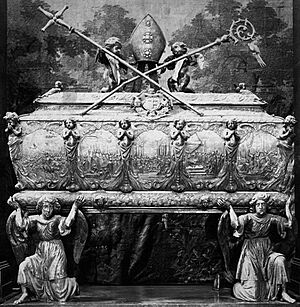Silversmith facts for kids
A silversmith is a metalworker who crafts objects from silver. The terms silversmith and goldsmith are not exact synonyms, as the techniques, training, history, and guilds are (or were, at least) largely the same but differed in that the end product may vary greatly (as may the scale of objects created).
History

In the ancient Near East (as holds true today), the value of silver was lower than the value of gold, allowing a silversmith to produce objects and store these as stock. Historian Jack Ogden states that, according to an edict written by Diocletian in 301 A.D., a silversmith was able to charge 75, 100, 150, 200, 250, or 300 denarii for material produce (per Roman pound). At that time, guilds of silversmiths formed to arbitrate disputes, protect its members' welfare, and educate the public of the trade.
Silversmiths in medieval Europe andEngland formed guilds and transmitted their tools and techniques to new generations via the apprentice tradition. Silverworking guilds often maintained consistency and upheld standards at the expense of innovation. Beginning in the 17th century, artisans emigrated to America and experienced fewer restrictions. As a result, silverworking was one of the trades that helped to inaugurate the technological and industrial history of the United States silverworking shift to industrialization.
Very exquisite and distinctly designed silverware, especially the artisanal craft that goes by the name of Swami Silver, emerged from the stable of watchmaker-turned-silversmith P.Orr and Sons in the South Indian city of Madras (now Chennai) during the British rule in 1875.``
Tools, materials and techniques
- saw (jeweler's saw)
- snips
- flat file
- jewelers' files
- planishing hammer
- raising hammer
- cross-pein hammer
- ball-pein hammer
- anvils
- stakes
- swage blocks
- riveting
- silver hard-solder
- flux
- torch or blow-pipe
- pickle (dilute sulphuric acid or organic acids which are used to remove firescale)
- buffing wheels
- polishing compounds.
- chasing
- repoussé
- engraving
Silversmiths saw or cut specific shapes from sterling and fine silver sheet metal and bar stock; they then use hammers to form the metal over anvils and stakes. Silver is hammered cold (at room temperature). As the metal is hammered, bent, and worked, it 'work-hardens'. Annealing is the heat-treatment used to make the metal soft again. If metal is work-hardened, and not annealed occasionally, the metal will crack and weaken the work.
Silversmiths can use casting techniques to create knobs, handles and feet for the hollowware they are making.
After forming and casting, the various pieces may be assembled by soldering and riveting.
During most of their history, silversmiths used charcoal or coke fired forges, and lung-powered blow-pipes for soldering and annealing. Modern silversmiths commonly use gas burning torches as heat sources. A newer method is laser beam welding.
Silversmiths may also work with copper and brass, especially when making practice pieces, due to those materials having similar working properties and being more affordable than silver.
Notable and historical silversmiths
- Acragas
- Kurt Aepli
- Zahroun Amara, world renowned Mandaean niello silversmith. People that are known to have owned his silver nielloware include Stanley Maude, Winston Churchill, the Bahraini royal family, Egyptian King Farouk, the Iraqi royal family (including kings Faisal I and Ghazi), and the British royal family including the Prince of Wales who became Edward VIII.
- Hester Bateman
- Peter Bentzon, the only early-American silversmith of African-ancestry whose silver has been identified.
- Jocelyn Burton
- Benvenuto Cellini
- Stephen Emery, early American silversmith
- Thomas Germain
- François-Thomas Germain
- Karl Gustav Hansen, Danish pioneer of Scandinavian silversmith design
- John Hull, Treasurer of the Massachusetts Bay Colony
- Isaac Hutton
- Georg Jensen
- Sampson Mordan
- Jean-Valentin Morel, French jeweler and craftsman
- Henry Petzal
- Paul Revere, American silversmith, manufacturer, and patriot
- Joseph Richardson Sr. and Joseph Richardson Jr., American silversmiths based in Philadelphia
- Atsidi Sani (Old Smith in English), the first known Navajo silversmith
- Alfredo Sciarrotta
- Sequoyah, Cherokee silversmith, inventor of the Cherokee syllabary
- Alice Sheene
- Robert Shepherd and William Boyd
- Robert Welch
- Edward Winlsow, early American silversmith
See also
 In Spanish: Platero para niños
In Spanish: Platero para niños
- Yemenite silversmithing
- Mouza Sulaiman Mohamed Al-Wardi
- Goldsmith




